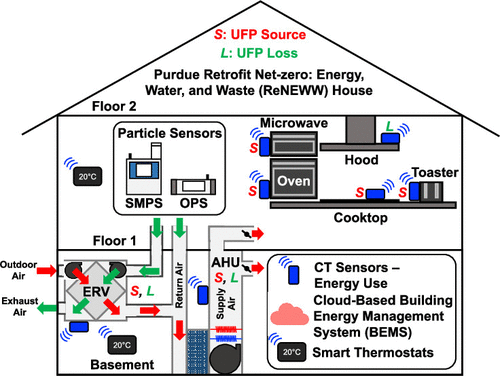当前位置:
X-MOL 学术
›
ACS ES&T Eng.
›
论文详情
Our official English website, www.x-mol.net, welcomes your
feedback! (Note: you will need to create a separate account there.)
Using Building Energy and Smart Thermostat Data to Evaluate Indoor Ultrafine Particle Source and Loss Processes in a Net-Zero Energy House
ACS ES&T Engineering ( IF 7.4 ) Pub Date : 2021-03-17 , DOI: 10.1021/acsestengg.1c00002 Jinglin Jiang 1, 2 , Nusrat Jung 1, 2 , Brandon E. Boor 1, 2
ACS ES&T Engineering ( IF 7.4 ) Pub Date : 2021-03-17 , DOI: 10.1021/acsestengg.1c00002 Jinglin Jiang 1, 2 , Nusrat Jung 1, 2 , Brandon E. Boor 1, 2
Affiliation

|
The integration of Internet of Things (IoT)-enabled sensors and building energy management systems (BEMS) into smart buildings offers a platform for real-time monitoring of myriad factors that shape indoor air quality. This study explores the application of building energy and smart thermostat data to evaluate indoor ultrafine particle dynamics (UFP, diameter ≤ 100 nm). A new framework is developed whereby a cloud-based BEMS and smart thermostats are integrated with real time UFP sensing and a material balance model to characterize UFP source and loss processes. The data-driven framework was evaluated through a field campaign conducted in an occupied net-zero energy building—the Purdue Retrofit Net-zero: Energy, Water, and Waste (ReNEWW) House. Indoor UFP source events were identified through time-resolved electrical kitchen appliance energy use profiles derived from BEMS data. This enabled determination of kitchen appliance-resolved UFP source rates and time-averaged concentrations and size distributions. BEMS and smart thermostat data were used to identify the operational mode and runtime profiles of the air handling unit and energy recovery ventilator, from which UFP source and loss rates were estimated for each mode. The framework demonstrates that equipment-level energy use data can be used to understand how occupant activities and building systems affect indoor air quality.
中文翻译:

使用建筑物能源和智能恒温器数据评估净零能耗房屋中的室内超细颗粒物源和损失过程
将支持物联网(IoT)的传感器和建筑能源管理系统(BEMS)集成到智能建筑中,为实时监控影响室内空气质量的众多因素提供了一个平台。这项研究探索了建筑能源和智能恒温器数据在评估室内超细颗粒动力学(UFP,直径≤100 nm)中的应用。开发了一个新框架,该框架将基于云的BEMS和智能恒温器与实时UFP感应和物料平衡模型集成在一起,以表征UFP的源和损失过程。通过在一个零能耗的净能耗建筑中进行的野外评估对数据驱动的框架进行了评估,该建筑物是“普渡大学改造净零能耗:能源,水和废物(ReNEWW)之家”。室内UFP源事件是通过从BEMS数据得出的时间分辨的厨房电器能耗情况来确定的。这样就可以确定厨房用具解决的UFP污染源比率,时间平均浓度和尺寸分布。BEMS和智能恒温器数据用于识别空气处理单元和能量回收呼吸机的运行模式和运行时配置文件,从中可以估算出每种模式的UFP源和损失率。该框架表明,可以使用设备级别的能源使用数据来了解居住者的活动和建筑系统如何影响室内空气质量。BEMS和智能恒温器数据用于识别空气处理单元和能量回收呼吸机的运行模式和运行时配置文件,从中可以估算出每种模式的UFP源和损失率。该框架表明,可以使用设备级别的能源使用数据来了解居住者的活动和建筑系统如何影响室内空气质量。BEMS和智能恒温器数据用于识别空气处理单元和能量回收呼吸机的运行模式和运行时配置文件,从中可以估算出每种模式的UFP源和损失率。该框架表明,可以使用设备级别的能源使用数据来了解居住者的活动和建筑系统如何影响室内空气质量。
更新日期:2021-04-09
中文翻译:

使用建筑物能源和智能恒温器数据评估净零能耗房屋中的室内超细颗粒物源和损失过程
将支持物联网(IoT)的传感器和建筑能源管理系统(BEMS)集成到智能建筑中,为实时监控影响室内空气质量的众多因素提供了一个平台。这项研究探索了建筑能源和智能恒温器数据在评估室内超细颗粒动力学(UFP,直径≤100 nm)中的应用。开发了一个新框架,该框架将基于云的BEMS和智能恒温器与实时UFP感应和物料平衡模型集成在一起,以表征UFP的源和损失过程。通过在一个零能耗的净能耗建筑中进行的野外评估对数据驱动的框架进行了评估,该建筑物是“普渡大学改造净零能耗:能源,水和废物(ReNEWW)之家”。室内UFP源事件是通过从BEMS数据得出的时间分辨的厨房电器能耗情况来确定的。这样就可以确定厨房用具解决的UFP污染源比率,时间平均浓度和尺寸分布。BEMS和智能恒温器数据用于识别空气处理单元和能量回收呼吸机的运行模式和运行时配置文件,从中可以估算出每种模式的UFP源和损失率。该框架表明,可以使用设备级别的能源使用数据来了解居住者的活动和建筑系统如何影响室内空气质量。BEMS和智能恒温器数据用于识别空气处理单元和能量回收呼吸机的运行模式和运行时配置文件,从中可以估算出每种模式的UFP源和损失率。该框架表明,可以使用设备级别的能源使用数据来了解居住者的活动和建筑系统如何影响室内空气质量。BEMS和智能恒温器数据用于识别空气处理单元和能量回收呼吸机的运行模式和运行时配置文件,从中可以估算出每种模式的UFP源和损失率。该框架表明,可以使用设备级别的能源使用数据来了解居住者的活动和建筑系统如何影响室内空气质量。









































 京公网安备 11010802027423号
京公网安备 11010802027423号